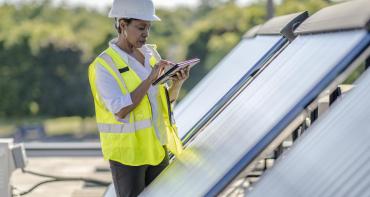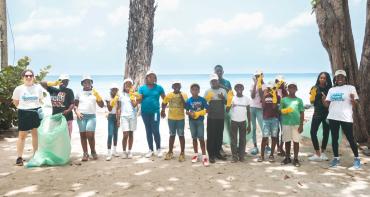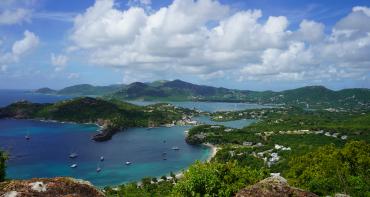New assessment finds Sri Lanka vulnerable to extreme rising temperatures and coastal flooding, and identifies investments and recommendations needed to protect coastal communities

The Government of Sri Lanka through the Ministry of Foreign Affairs, the Stimson Center’s Environmental Security Program, and the Commonwealth Secretariat through the Commonwealth Blue Charter programme announced today the completion of a rapid assessment of climate and ocean risks and options to address these risks in the island nation.
Working together in partnership, the three organizations collected data on the extent of climate and ocean risks affecting Sri Lanka’s Western Province and surveyed dozens of local experts to determine priority climate action and steps for the country to undertake in 2022 and beyond.
The CORVI Rapid Assessment identified significant financial and political risk, particularly in economics, highlighting the challenges of a country in the midst of its worst economic crisis since gaining independence in 1948. The assessment was conducted over six months and is comprised of 30 risk indicators.
The report made three priority recommendations:
- Invest in climate-smart infrastructure and community-based adaptation in vulnerable neighborhoods, such as improving drainage systems, replacing pavement with permeable surfaces, and restricting development on wetlands and floodplains in partnership with community organizations.
- Build resilience in marine and coastal ecosystems that are vital mitigate the impact of frequent flooding.
- Enhance the climate adaptability of key industries, such as tourism, garment production, shipping, and agriculture which together comprise a major part of the Sri Lankan economy.
Full details of each recommendation are below. Or read the report.
Source of recommendations
These recommendations stem from the highest risk indicator scores including Debt Ratio (9.17), and Level of Informal Economy (7.72) which have presented challenges for the country recently and historically as noted by the 16 loans obtained from the International Monetary Fund since 1965. Smaller, less efficient firms, unable to access formal credit, characterize a large informal economy and constrain economic growth. The second highest risk indicator score, Market Losses from Extreme Weather Events (8.20), illustrates how these challenges are exacerbated by annual flooding. The World Bank has projected average annual losses of approximately $800 million, equivalent to one percent of Sri Lanka’s economy. From an ecological standpoint, the number of flood events and nearshore fish stock status are the highest ecological vulnerabilities for the Western Province of Sri Lanka. The province frequently experiences heavy flooding due to heavy rains, which often impacts those living in informal settlements the most.
Ms. Hasanthi Urugodawatte Dissanayake, Additional Secretary, Ocean Affairs, Environment and Climate Change at the Foreign Ministry – Sri Lanka, said
“The findings of this report show so clearly that climate risks such as rising temperatures and seas are directly linked to our economic well being. Flooding, drought and coastal erosion, among other climate impacts, threaten our natural environment and our tourism-based economy, but they also have lasting impacts on our economic strength. The data from the CORVI Rapid Assessment will help us to intervene against the highest priority threats and allocate our limited resources in the right places.”
Full recommendations
Details behind the recommendations for Sri Lanka determined from this research include:
-
Invest in climate-smart infrastructure and community-based adaptation in vulnerable neighborhoods: The Metro Colombo Urban Development Project has helped to mitigate flood risk, but Sri Lanka can take additional steps to reduce the impacts of flooding in the most vulnerable neighborhoods. This may include a strategic combination of actions, such as improving and clearing drainage systems, replacing concrete and pavement with permeable surfaces, restricting development on wetlands and floodplains, and creating spaces that can retain rainwater. Multi-sectoral partnerships to share knowledge, expertise, and resources are likely to improve the success of such measures. Incorporating community-based organizations is particularly valuable, both in the decision making process and in the implementation of infrastructure projects and early warning systems.
-
Build resilience in marine and coastal ecosystems: Marine and coastal ecosystems in the Western Province provide vital ecosystem services that can mitigate the impacts of frequent flooding. These services include flood control, water purification, and erosion regulation. The national, provincial, and local governments could expand their work and partner with the private sector to conserve remaining wetlands, mangroves, seagrass, and coral reefs. This work could include both new government regulations as well as better government enforcement of existing regulations, such as the ban on coral mining. Further, there is a need for better management of solid waste, wastewater, and agricultural runoff to minimize the contamination of marine ecosystems. The government might also consider debt-for-nature swaps, which forgive a portion of a country’s external debt in exchange for passing environmental policies and commitments to improved biodiversity conservation.
-
Enhance the climate adaptability of key industries: The tourism, garment production, shipping, and agriculture industries comprise a major part of the Sri Lankan economy. Mitigating these sectors’ exposure to climate risks such as increasing temperatures, drought, and flooding is important. Similarly, reducing any associated negative impacts on coastal and marine ecosystems, such as solid waste pollution and chemical contamination from shipping accidents, is also important. For tourism, this includes building awareness of climate risks and mitigation strategies among industry stakeholders, improving regulations around solid waste management, and establishing plans to coordinate response in the event of an extreme weather event. For shipping, there is a need to focus on enhancing safety standards and improving accident response plans to reduce the sector’s harms to coastal and marine ecosystems, thereby helping to preserve the benefits offered by those ecosystems. For agriculture, the government could work with community-based organizations to improve uptake of climate-smart agricultural practices, including flood- and heat-tolerant crop varieties, seasonal-adapted planting schedules, and dry sowing techniques.
“The completion of this pilot project provides Sri Lanka with a new, and clearer path to deal with some of these most urgent climate impacts. Armed with this information, the Sri Lankan government and community can build on the hard work of building out its climate-smart infrastructure, build resilience in marine and coastal ecosystems and enhance the climate adaptability of its key industries.”Share on TwitterHeidi Prislan , Adviser for the Commonwealth Blue Charter
“Sri Lanka’s blue economy relies heavily on its tourism and fishing industries, which are threatened by floods and overexploitation of fish stocks respectively. When climate risks threaten the economy directly, political instability, and even upheaval can occur. The rapid assessment helps to provide the Sri Lankan government with the information it needs to fill knowledge gaps, make these connections, and prepare them to take action to build climate resilience where it is needed most.”Share on TwitterSally Yozell , Senior Fellow, Director of the Stimson Center’s Environmental Security Program, and project lead for CORVI
About the CORVI Rapid Assessment
The Rapid Assessment is based on and complements the full Climate and Ocean Risk Vulnerability Index (CORVI) tool, an innovative risk analysis tool that compares a diverse range of economic, social, and environmental risks to produce climate and ocean risk profiles for coastal cities. These detailed profiles help governments, businesses, and financial institutions assess climate risk and pinpoint key areas of action to help the government adapt to the climate emergency. As one of three pilot project countries, Sri Lanka will work with expert analysts to review the results, better understand the available options, and formulate next steps that can be taken in order to develop climate-smart policies based on the report’s recommendations.
This project was supported by the Ocean Risk and Resilience Action Alliance (ORRAA) and was funded with UK aid from the UK government. For more information on Stimson’s Climate Security project and CORVI, visit https://www.stimson.org/project/corvi/
Media contact
Commonwealth Blue Charter
Josephine Latu-Sanft
Stimson Center
Caitlin Goodman or Lily Goldman



